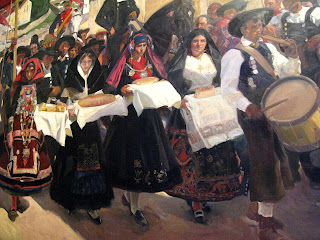Hi everyone. I've had a break and am happy to have something new to offer.
I have been painting on location more this fall, in Taos with Alla Prima International, and elsewhere, so I have a pile of partly finished paintings. I thought it might interest you to see the changes I make as I take a fresh look at the works and make changes to improve and complete the paintings.
To do this, I first look for faults in the composition. All the refinement in the world won't help if the composition is weak. Also, it is easier to make myself make big changes at this stage than after I've labored over its details.
Now, let's look at the first one.
The "Alla Prima Donnas", as Rose Hohenberger dubbed us - it's an all-female group, after all - went to the site of an old mission in Taos on this October day. I set up my easel for the first painting of the day near where we parked with a view of the back of the decaying structure. I was attracted to this tree just screaming its joy in the cooling weather, though only part of the tree was yellow. A single-rail fence marked the boundary for the parking area and a dip was between me and the yellow tree. This dip had tall weeds in shadow close to me and a railing for an unseen deck of the house that was out of the picture on the right. This railing would add structure to that area.
Unfinished painting after plein air session
As I evaluated the composition of the plein air work, I felt there was too strong a diagonal across the piece and decided to counter it, somehow. The yellow tree was painted as it was, with only the branch in its fall color, while the rest was still green. This looked as if the tree was unbalanced and about to topple to the right. The wall of the building had no windows or doors and offered nothing of interest for the viewer. Most of the lines in the composition lead to this building, but why go to a blank wall?
Finished painting
"Delivery" - Oil - 12" x 16"
To reconcile the leaning tree, I moved the calendar forward a bit and painted the entire tree yellow, the left-hand portion in shadow. I darkened the yellow leaves at the top of the painting and softened those edges. Since the big gap in the trees over the building looked improbable, I extended the foliage over that area.
To describe the dip as a slope, I placed a figure of the correct size for the scale of the distant building as if he were walking up a path. His vertical form also broke that severe diagonal. Lastly, I added a window to the building, giving it more depth and interest.


















































